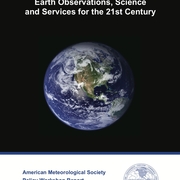This Study is now available for download
Key Findings and Recommendations:
Earth observations, science, and services (Earth OSS) inform and guide the activities of virtually all economic sectors and innumerable institutions underlying modern civilization. Increasingly, Earth OSS are a fundamental component of efforts to meet basic human needs such as providing food, shelter, energy, health, and safety. At the same time, the opportunities for societal benefit from Earth OSS are ever increasing.
Taken together, Earth OSS in the United States comprise a national asset that, if lost or degraded, will not meet future societal needs that span the whole of the national agenda. This infrastructure is not concentrated but widely distributed across Federal agencies and all levels of government, throughout an extensive and growing private sector, and in university research laboratories.
Earth OSS face considerable challenges. Most notably, economic downturns and Federal budget deficits put efforts to build and maintain our Earth OSS capabilities at serious risk. Furthermore, the increasing cost of satellites creates challenges for NOAA, NASA, and the military. NASA’s Earth observing satellite fleet is aging, making the potential for failures and gaps in data continuity considerable. For NOAA, satellite operations are a large fraction of the agency’s overall budget. As a result, small expansion of satellite budgets (proportionally) can consume the resources needed for other critical Earth OSS programs.
Unfortunately, few policy makers or members of the public recognize the importance of Earth OSS and most take the necessary infrastructure for granted. This creates a challenge because the demand and support for Earth OSS is weaker than justified by the scale and scope of the societal benefits that result.
Opportunities to improve the provision and use of Earth OSS also abound. Most notably, improvements in Earth OSS are possible through 1) increased investment designed to shore up and expand U.S. Earth OSS capability, 2) more effective use of limited re- sources through improved prioritization, 3) better communication among Earth OSS providers, users, decision makers at all levels (federal, state, and local), and the public, 4) improved collaboration, 5) more effective Federal policy, 6) better linking of observations and science to services, and 7) creative problem solving to address multiple un- related societal needs simultaneously.
Key findings of this report:
1. Earth observations, science, and services (OSS), taken together, constitute a key national infrastructure, critical to ongoing efforts in the United States to:
A. Use Earth’s natural resources (including, but not limited to, energy, food, and water) most effectively,
B. Protect and maintain environmental quality, essential biological re- sources, and planetary life-support services, and
C. Promote public safety, health, and uninterrupted economic activity in the face of natural hazards.
2. There is a common Earth OSS infrastructure that simultaneously supports and enhances multiple sectors of the U.S. economy including: agriculture, energy, transportation, water resource management, public health, and national security.
3. The continued viability of Earth OSS infrastructure is at risk because of inadequate and intermittent rates of investment in its development, function, and maintenance.
4. Improvements to the existing policy framework have considerable potential to enhance Earth OSS capabilities and use in critical economic sectors.
In order to ensure the adequacy and continuity of Earth OSS over the short, intermediate, and longer term, this report recommends national policies for Earth OSS that:
1. Identify current and future needs and priorities;
2. Articulate a range of options for supporting existing and emerging public— private partnerships;
3. Foster the necessary communication and collaboration among natural and social scientists, scientists and service providers, service providers and communication experts, service providers and users, Federal agencies, and domestic and inter- national providers;
4. Provide the national investments needed to support and further enhance this critical infrastructure.
5. Adapt readily and naturally to changing challenges and new opportunities.
In addition to these five recommendations, a sustained effort to conduct policy analysis and promote a high-level national discussion will be necessary to ensure the adequacy and continuity of Earth OSS over the short, intermediate, and longer term. Therefore, the American Meteorological Society (AMS) plans to make that sustained effort through a series of follow-on activities to conduct policy analyses and foster discussions that advance Earth OSS capacity.
